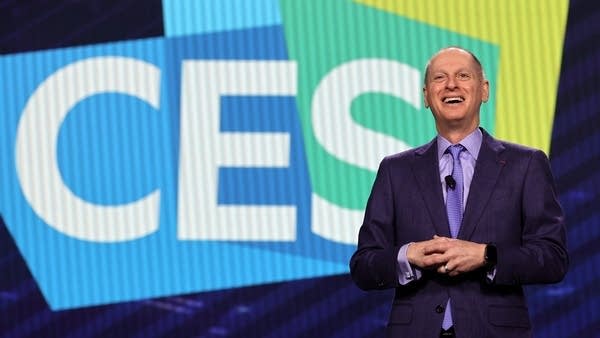The biggest consumer tech event of the year is underway in Las Vegas. Gary Shapiro, head of the organization behind CES, says AI, health care and sustainability are front and center at this year’s showcase.

This week, more than 100,000 people from around the world — including staff of “Marketplace Tech” — are gathered in Las Vegas for one reason.
No, we’re not here to gamble, at least not during work hours. We’re here to talk tech at the annual Consumer Electronics Show. This year CES features more than 4,000 exhibitors, from small startups to tech giants like Amazon, Intel and Sony.
There’s so much to see in so little time, so Marketplace’s Lily Jamali spoke with Gary Shapiro, president and CEO of the Consumer Technology Association, which runs CES, about what to watch for at this year’s event.
The following is an edited transcript of their conversation.
Gary Shapiro: It’s been just about a year since the generative AI breakthrough, and now AI will be a part of a lot of different companies’ exhibits throughout the show floor. There are big trends in health care technology still stemming from how we deal with COVID and the fact that the world has a shortage of doctors, nurses and technicians, and technology is filling the gap. And of course, there will be exhibits about mobility, where you have not only electric cars, but you also have self-driving cars and flying cars, mobility on the water, all sorts of sustainable types of options.
The overall big theme of the show is sustainability. In 2023, we partnered with the United Nations, and we focused on these seven big goals having to do with human securities. Things like food security, you have a right not to be hungry. Same thing with health care, clean air, clean water, community. Well, they’ve added a new one, which is access to technology. So that is something you’ll see throughout the show — different ways of getting these basic human needs addressed through all sorts of technology. We used to be a show about audio and video alone, and now we’ve expanded and there’s so many more things that affect the fundamental human condition.
Lily Jamali: How quickly do the technologies that we see at CES end up trickling into the lives of consumers? Is there a pretty big lag time there?
Shapiro: Sometimes there is and sometimes there isn’t. Sometimes the companies use CES to announce something they want to sell that year and get into consumers’ hands. If you’re talking about a chip company, for example, they’re talking about the future themselves. The chip companies are where a lot of other companies go to get the products and the innovations they want, and that’s a much longer lag time. But we’re seeing things this year that we haven’t seen before. For the first time we have a beauty tech keynoter, from the L’Oreal CEO. And there’s a lot there for empowering all consumers, not just those that are able-bodied, but also people with disabilities. All different types are being assisted by all sorts of different technologies.
Jamali: What about gaming? Your group, the Consumer Technology Association, is projecting that gaming will be one of the strongest categories in consumer tech. What’s going to be driving that?
Shapiro: Gaming seems to be cyclical, depending on whether there’s a new platform upgrade from one of the big providers, but clearly, there’s evolution going on in gaming, from the desktop to the TV, where a lot of people like to play games because it’s bigger and more visual. But there’s also evolution occurring in terms of interactivity, the ability to play online with so many other people, the ability to do egaming. And you see companies at CES like Sony and others showing all sorts of things and content. There’s also the virtualization of the games with virtual reality and augmented reality, the addition of different elements into the games, which allow, in a sense, vibration or smells or sounds to occur. So there’s so many different things happening at the same time in gaming, but it’s a global phenomenon. It crosses national barriers.
Jamali: As we start things off with CES, what are you most excited about?
Shapiro: We have more than 4,000 exhibitors in 2.5 million net square feet of exhibit space. It’s the biggest international event in terms of having people come to the U.S. of any, including sporting events. So, when people get together, you can see the magic happen, the serendipity, the five-sense experience, the comparison of going from one incredible exhibit to another. And then you have 1,200 startups in an area, and you see the passion and the enthusiasm and the excitement. It’s just the whole interplay of innovation which is making the world better and challenging us as humans to be the best we can be and solve health care problems and transportation problems and problems we face in terms of making sure that this is accessible to everyone. So that’s what’s exciting. It’s the gestalt of innovation, making the world better in one place by people that are all passionate about it.
Jamali: If you had to pick, I know it’s hard, but did you have a favorite product from last year?
Shapiro: My favorite product from the 2023 show was the smart John Deere tractor. It saved resources like water, seeds, fertilizer to help with going forward in a limited-resource environment in a sophisticated way, by using technology to produce something that we need, which is food.